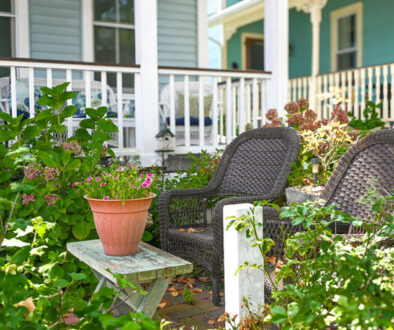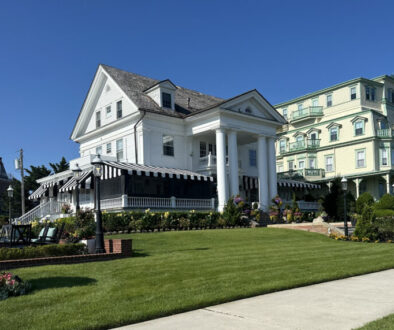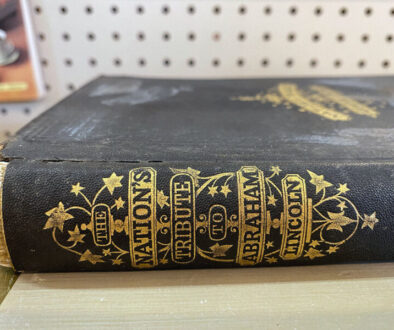Ministering Kindness

From the earliest days when indigenous Lenni Lenape first encountered English settlers, some of whom were second-generation descendants of Mayflower pilgrims, the cultural fabric of Cape May County has been ever-changing. It’s been woven by Swedish settlers of the 17th century who established the Cape’s fishing industry and later by Italian, Irish, and Polish immigrants whose surnames would become synonymous with the building of our shore communities.
36-year-old Father Cesar Pirateque Serrano is a spiritual and community leader to a new wave of settlers from Latin America who are now reshaping our county’s cultural landscape once again.
Born in Bogota, Colombia in 1987, the son of a military barber, Father Cesar’s early life was as far from the priesthood as it was from Cape May.


“We were very poor,” Father Cesar said. “When I was 17, my father asked me what I wanted to do with my life. I didn’t want to be an added burden on my family by going to the university, so I decided to join the Colombian Navy where I learned electronics with a specialization in radar.”
Cesar’s naval operations entailed high-risk encounters with guerrillas, confiscations of cocaine shipments, and interceptions of the poaching and export of exotic animals. Most disturbing were the instances of human trafficking and the guerrillas’ recruitment of children for combat training and sex.
“They put me in the Amazon jungles for three years,” Father Cesar said. “When I saw what other humans do, I saw that as evil but never connected it to a lack of God. I was raised Catholic but was not living my faith.”
Two of the most harrowing operations to which Cesar had been sent became a spiritual catalyst that would change his life.
“One night on the Amazon we were told by intelligence that we had to capture a canoe with paste [residue left at the bottom of a barrel] of cocaine,” Father Cesar said. “We were told they would be heavily armed. It was completely dark. I was 23 and thought, ‘What if I die here?’ Another night we stopped a ship in the middle of the jungle. There is a type of guerrilla trained in stealth tactics to kill you and take your gun. I was on watch from midnight onward. That was intense because we knew they were here to kill. That was the second time I thought, ‘What if somebody kills us?’ Our other ship was shot by a rocket and the side of it was destroyed. One of our men was killed. The following morning, I saw the sunrise and truly asked myself if I really believed what God was saying. All this time my spiritual life was being built in the secret and silence of God.”

Cesar began to find solace and refuge in the navy chapel, often going there in the night while other sailors were asleep. It wasn’t long before Cesar became the Sacristan, cleaning and overseeing the care and order of the chapel.
Even with a steady girlfriend and going on to study aviation, Father Cesar recalls not feeling completely fulfilled.
“One day my mother asked if I was happy,” Father Cesar said of the day he made the decision to be a priest. “I told her I was, and she said I didn’t look it. With a very simple faith, she said, ‘Why don’t you bring that to Our Lady?’ That day in adoration of the Blessed Sacrament, for the first time in my life, I was honest with myself. I fell on my knees and prayed, ‘If you are really there, tell me what you want.’”
The answer he heard was his first step toward the priesthood.
Years later, while on a trip to Colombia, Bishop Dennis Sullivan of the Camden Diocese met Father Cesar, who was finishing his seminary studies, and invited him to New Jersey. Newly ordained in 2022, Father Cesar served at Notre Dame De La Mer Parish in Wildwood for a year before being transferred to the Parish of St. John Neumann in Lower Township as Parochial Vicar. The Parish consists of two campuses, St. John of God in North Cape May and St. Raymond Church in Villas.
In 2023, Bishop Sullivan designated St. Raymond Church as the base for a regional ministry to the Latino community with Father Cesar leading its efforts.
A recent census shows there are approximately 8,000 Latino residents in Cape May County. Although currently representing less than 10 percent of the county’s population, this demographic has more than doubled since 2010. However, this official census is only a fraction of the actual number of Latinos living here.
“Here in the Parish of St. John Neumann,” Father Cesar said of these discrepancies, “we have approximately 1,100 registered households. Our number of registered Latino parishioners is far less than the over 200 Latino families we minister to. The reasons are that registering for things is not part of our culture as it is in the United States. As a child in Colombia, my family was never registered in a particular church. One week we would walk to one church for Mass and the following week we might walk to a cathedral for another. Registering is just not something that is done. You also must remember that many Latinos here may not have papers. Even those who are here legally are new and have fears of registering or reporting for memberships and a census.”
“They are coming here and crossing borders for a number of reasons,” Father Cesar said. “They may be coming to find work and earn money. They may be crossing borders to escape communism or persecution or a dictatorship. About 90 percent are from Mexico, with an increasing number of Guatemalans.”
The rapid increase in the Latino population is a recent development in our county’s growth. Nathan Garcia, a 57-year-old retired New York City police sergeant, relocated to North Wildwood in 1977 at the age of 10 when his Puerto Rican-born mother and stepfather moved from the Bronx. Having spent his formative years here before moving back to New York as an adult, Nathan recalls a less diverse ethnic landscape when he arrived.

“I was the only Puerto Rican kid in Margaret Mace elementary school,” Nathan said of the North Wildwood public school. “I remember that Mark Soto was the only Puerto Rican kid in Wildwood Crest and Jimmy Lopez and his family were the only ones in Wildwood. That was all. We were it on the island, although I heard there was another Puerto Rican family in Whitesboro.”
Navigating as a newcomer in an already established community can prove intimidating for anyone. Add to that challenge a language and cultural difference and the situation becomes daunting for many, often revealing a clear and less-than-caring demeanor from others.
“People associated Puerto Rican with low status or being a street thug,” Nathan said of his struggles being accepted growing up in Cape May County. “People defined me back then and I didn’t know any better, so I looked for an identity that I hoped would be accepted. There was plenty of blunt racism, and plenty of patronizing liberals who believed that without their help we’d still be swinging in trees. But there were just as many people trying to see me as an individual. When I left the area after high school and enlisted in the U.S. Marines, I saw that I was responsible for my own identity.”

Father Cesar discusses what he calls a clear “pushback” from those in the community toward the recent Latino residents. “There is often a less than welcoming attitude toward Latinos,” Father Cesar said. “It’s a bad pride that goes against the value of Christianity. Those in the non-Latino community will welcome tourists with open arms because they are spending money. But those without money are not always treated the same. I felt that once myself in the other parish and I felt a pain in my heart.”
As a boy in Cartagena, Chile, Mauricio Morales had always dreamed of coming to the United States.
“I came here in 1992 and worked with friends in New York doing construction,” Mauricio said. “Just after that I moved to Cape May County and continued working in construction and renovations in Atlantic City. I was also determined to learn the language.”
By 2006, Mauricio was working with DL Miner Construction. “I started at the bottom,” Mauricio said. “Within a few years I had worked my way to a management position with them.”
At 56 years old, Mauricio now owns his own construction company, MCM Builders, as well as having a partnered ownership in Coastal Modern Construction. His company is sought after by high-profile architects and homeowners for his skilled craftsmanship and attention to detail.
“In the beginning I didn’t see any discrimination or prejudice toward me as Latino,” Mauricio said of the adversity faced by many Latino immigrants. “I wasn’t even worried about it. But as I became more successful, I found I was being compared to other people or being looked down on. I knew more about my profession than many in the industry, and they did not like that.”
Despite his success and entrepreneurial achievements, Mauricio remains humble, yet freely gives advice to other Latino immigrants who are seeking similar success in their chosen careers.
“Many people don’t realize I am the owner of the company, even those who first come to work for me,” Mauricio said. “I am not concerned with titles or impressing people, I just want to get my work done right. I have had other Latino people look at me with jealousy for what I have been able to accomplish, but they don’t see the years of hard work that got me here. Many who just arrive in the United States have asked for my advice. It’s very simple: I tell them to learn English, follow the rules, and don’t ever cut corners.”

Mauricio’s advice to the non-Latino community is just as simple. “Please give people a chance,” Mauricio said, “regardless of their color or culture.”
Through his ministry, Father Cesar also emphasizes the need for fairness and understanding. “They are not asking for everything once they get here,” Father Cesar said. “They are here to work and build a better life for themselves.”
An unfortunate consequence of many undocumented migrants is the harsh light in which they and the Latino community at large have been cast. Unfair treatment and prejudice toward Latinos have increased as quickly as the population itself.
“There are many who come here and choose to do evil things, but there are many good people in the Latino community,” Father Cesar said of generalizing all migrants as potential criminals. “When I first came here, the big joke about me being from Colombia was, ‘Oh, you sell cocaine?’ People generalize. Sometimes they are here as aliens without documents. Their legal status is not in front of their necessity. I have gone into homes where children are sleeping on the floor or on moldy mattresses that have been found in the trash. I don’t care if they have no papers. If they are hungry, I will help them. If I am in a relationship with God, how can I not recognize the needs of another?”
“This ministry based at St. Raymond Church takes care of the needs of the Spanish speaking Catholics in Cape May County,” Father Cesar said. “We have people coming from all parts of the county. I am working alone but have all the support of Father Jamie King (Pastor of Parish of St. John Neumann) and the bishop.”
The most notable feature of the ministry has been the parish’s inclusion of Spanish language Masses. The altar of St. Raymond’s and its surroundings are adorned with lavish floral displays in celebration of various holy days of obligation on the liturgical calendar. The most spectacular of these efforts from the Latino parishioners was in 2023 with the creation of a floor-to-ceiling grotto at Christmastime, complete with waterfall and live evergreen trees nestling a large nativity scene.
“Latinos are deeply devotional,” Father Cesar said of their more expressive manner of worship. “We have processions, Rosary on our knees with open arms. That is what we have brought from our countries. It is who we are. The expressions of faith in many Latin American countries are different than in the United States. There is separation of church and state here, which is good. In my opinion, this is a Protestant country ruled by secularism. In Colombia, for instance, we have a Catholic constitution. Those of us from Latin America come from a Catholic root.”
Marge Oxley, an Extraordinary Minister of Holy Communion at St. John Neumann Parish, also serves as a catechist, teaching CCD (Confraternity of Christian Doctrine) to Latino children. She shares sentiments that are being expressed by other non-Latino parishioners.
“Our parish is embracing the Latino culture,” Marge said of the increasing presence of Latino families and their customs. “We’re appreciating new ideas and different perspectives which enhance our way of worshiping God together. The Latino children in my CCD class are delightful. They care so much for each other, and I see that as the biggest boost to their self-confidence. They have a very bright future.”

Celebrations of the culture are spectacular at St. Raymond Church. Mexican-themed dinners in the church hall provide fellowship among those attending from all corners of the county. Basketball for Heaven, a basketball tournament Father Cesar initiated to bring the community together, saw nearly 400 attendees at its first game.
“We need these things for our community,” Father Cesar concluded. “First- and second-generation immigrants don’t speak English, but I am told that the third and fourth generations will. This is a time of bonding and growing and learning for them. I am here for them as a father of my spiritual children, firm in truth and tender in love. I ask that everyone remember that the value of being a child of God is higher than any law when someone is in need.”



